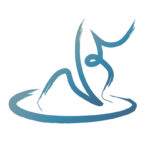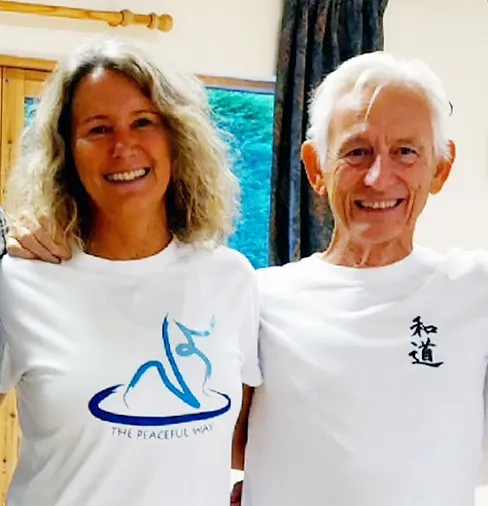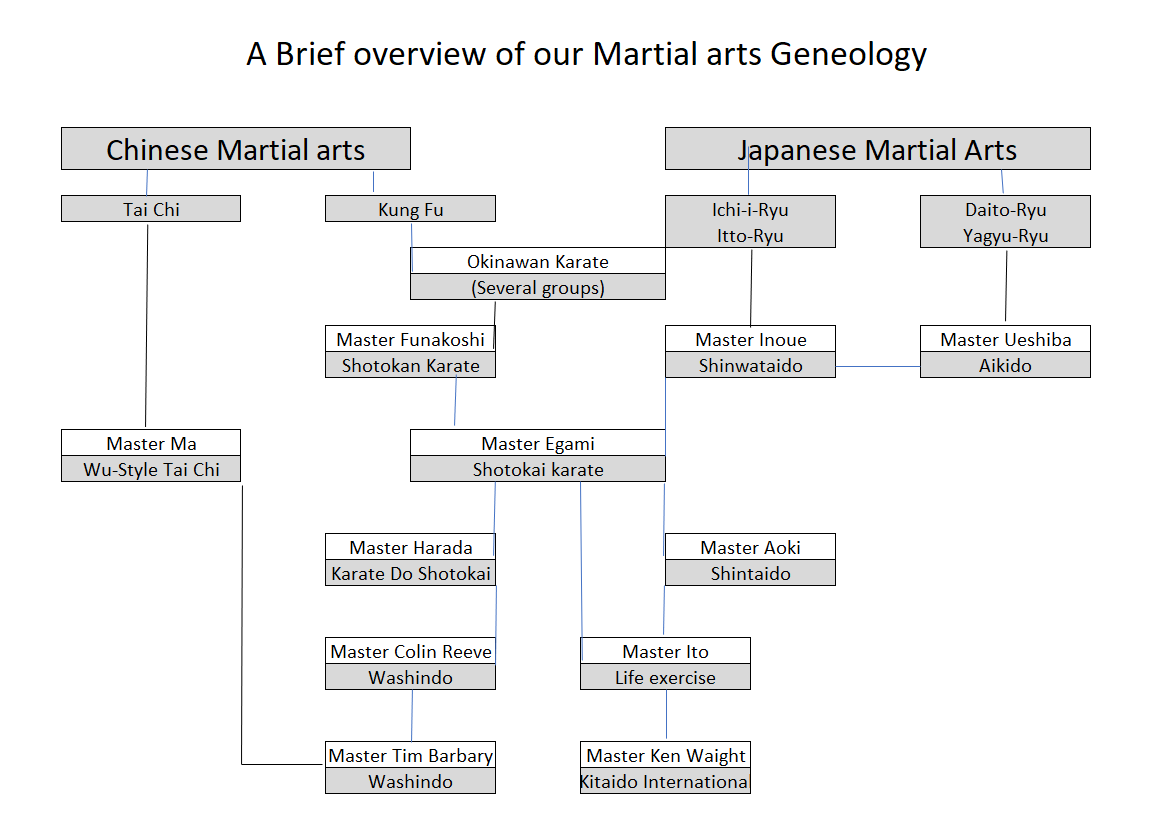Tim comments on his journey to date
If one really wishes to be master of an art, technical knowledge of it is not enough. To master one must transcend technique so that the art becomes an ‘artless art’ growing out of the unconscious.
In the text of this website are our core principles and currently identified ways associated with the practice of Washindo. As we are a dynamic organisation you can expect more to be added over time.
These are simply guides we have discovered on the path towards Mastery it is not the destination as we anticipate more to reveal itself on the journey.
I have had the great fortune and privilege to practice and learn from my Shihan (Master of Masters) Colin Reeve whose insights, practices, writings, and most of all his patience has enabled me to practice over the years and has continuously guided me as I have searched, learned and latterly teach.
I would also thank everyone I have ever practiced with, as each in turn has helped me to better understand the connections between the cognitive, physical, and spiritual aspects of martial arts.
In particular great 5th Dans / master’s and friends with whom I have been taught by and practiced with over my 35 years: Karen Stone, Jim Reid, Steve Culshaw, Tricky (Richard Wilson), Robert Deliner, Roger Henderson, John Dagnall and Paul Waters.
I would also like to especially thank Master Adrian Baker and 5th dan Kathryn Thorpe of KaiZen (south West) for their leadership and continual guidance which is always greatly appreciated.
– Tim Barbary
What Washindo means to me
A Poem by Tim Barbary
Washindo is the way of the peaceful heart
A practice for life in which I take part.
Washindo embraces energy, that’s not easily found,
Engaged with from above and below the ground.
Developed from arts: Yoga, Karate and meditation,
embodying strength & mental focus – leading to improved concentration.
Not relying on aggression, size, gender, or strength,
but blending of energy with mind, body, and breath.
Harmonising movement of the body with your breath,
helps bring grace and power to movement – the calmness is strength.
Washindo is not teaching people how to fight,
it’s how to live successfully without getting uptight.
Our bodies in the present & aligned, with power and range,
our lives never the same as we constantly strive to change.
Stretching our minds researching articles and old master texts,
Integrated into our bodies – that’s true mindfulness.
Once the Paradigm shifts, everything that was previously thought – impossible,
e.g. traditions, limiting beliefs, thoughts and actions – are now reversible.
Skills often hidden in the practice, and learnt by accident.
are now explored by design, they are alive and effervescent.
We will never know how long we will live for,
but can now influence the quality of life, like never before.
An energy that’s available at any time, night, or day,
For a lifetime of peace & harmony – this is the Washindo way.

Our Founder
The developer and leader of Washindo worldwide, Colin has developed this peaceful martial art from over 57 years of practice, study and teaching of Karate-do.
The practice and teaching of Washindo has been influenced and advanced by learnings from other great arts including yoga, kyudo and mindfulness meditation.
Through his study of Neuro Linguistic Programming (NLP), somatics and coaching, he has ensured the practice and teaching of Washindo is constantly evolving and up to date. Colin has reached the most senior level of Shihan (Master of Masters) and has taught around the world including Finland, Portugal, France, Germany, Monte Carlo, U.S.A, Belgium and Greece.
He works as a Leadership Consultant and Coach and is an NLP Master Trainer and Clinical Mindfulness practitioner.
He has written 2 books on Washindo and the Peaceful Way.
Fully living and practicing the principles of wellbeing, he is an exemplar for living healthier for longer, practicing meditation, Washindo and yoga daily, eating well and always having a positive mindset.
Karen also pictured is Colin’s partner, a Washindo Master and qualified Yoga instructor.
1883
Morihei Ueshiba born in Tanabe
1868
Gichin Funakoshi born in Okinawa
1902
Hoken inoue born in Tanabe
1912
Shigeru Egami born in Kyushu
•Inoue trained in ancient system of royal protection
1915
Inoue joins Morihei Ueshiba in Hokkaido
• Ueshiba meets Takeda Sokaku and starts studying Daito Ryu Jujutsu
1936
Hiroyuki Aoki born in Yokohama
1922
Gichin Funakoshi founds Shotokan Karate in Tokyo
• Inoue challenges head of Hozoin ryu
1927
Inoue and Ueshiba found Aikibudo in Tokyo
• Egami enters Waseda University and starts studying Shotokan Karate
• Inoue asked by Showa emperor to be his bodyguard
• Egami challenges Ueshiba
1932
Egami named Head Instructor of Shotokan Karate
1939
Egami teaches secret agents at the Nakano
1942
Haruyoshi Fugaku Ito born in Hiroshima
• Morihei Ueshiba founds Aikido
1943
Tadao Okuyama takes over Egami's position at the Nakano
1945
Colin Reeve born.
1950
Tadao Okuyama leaves Shotokan Karate to pursue his own style
1955
Harada introduces Karate to Brazil
1956
Hoken Inoue founds Shirwataido
• Aoki enters Chuo University and starts studying Shotokan Karate
• Tadao Okuyama introduces Egami to Hoken Inoue
• Harada recieves 5th Dan from Gichin Funakushi
1957
Gichin Funakoshi dies
• Egami starts studying Shinwataido while developing Shotokai Karate
• Aoki acting as deputy instructor (Shihan-Dal) for Master Egami in various Dojo
1960
Ito enters Chuo University and starts studying Shotokai Karate
1961
Egami introduces Aoki to Hoken Inoue
• Shigeru Egami founds Shotokai Karate in Tokyo
1963
Harada arrives in the UK
1965
Aoki founds Rakutenkai (September 23, 1965)
1964
Ito awarded 5th grade black belt Shotokai Karate by Master Egami
• Aoki tasked by Master Egami with the creation of Sogo-Budo
1966
Birth of Tenshingoso (April) and Eiko (December 1st)
• Rakutenkai takes the name Heiho Kenkyukai
• Gradual formation of Hikari to tawamureru
1969
Morihei Ueshiba dies
• Inoue challenges Koichi Tohei
1970
Heiho Kenkyukai takes the name Sogo-Budo Renmei
1971
Rakutenkai publishes ``Karate-do for professionals`` by Shigeru Egami
1972
Aoki changes the name Sogo-Budo to Shintaido
1975
Ito goes to America
1980
Ito organizes 1st International Shintaido Camp in San Francisco, USA
1981
Shigeru Egami dies
1982
Shintaido of America publishes ``Shintaido: the Body is a Message from the Universe`` by Hiroyuki Aoki
• 2nd Shintaido International meeting held in Bristol, UK
1984
3rd Shintaido International held in Pontarlier, France
1986
Wakame developed out of Hikari
1988
4th International Shintaido Camp held in Tanzawa, Japan
• Ito awarded first Shintaido Master Instructor degree by Master Aoki
1989
Tim Barbary began practicing Shotokai karate
• Ito awarded first Shintaido Master Instructor degree by Master Aoki
1992
5th International Shintaido Meeting held in Brighton, UK
1994
Hoken Inoue dies
1995
Taimyo Kata created by Master Aoki
1996
6th International Shintaido Meeting held in Sonoma, CA, USA
2000
7th International Shintaido meeting held in Haguro, Japan
• Ito dismissed as chairman of the IS Technical Committee by Master Aoki
2000
Adrian Baker began practicing 53 year ago and formed Kaizen in 2000
2001
Ito founds Taimyo Network for World Peace
2002
Ito meets Master Ma and starts studying Wu-style Tai Chi
2004
Ito almost dies
2006
Ito changes his lifestyle
2007
Ito meets our past
• Harada receives MSE from Queen
2008
Haruyoshi Fugaku Ito founds Life Exercise
2009
Tim Barbary became a 5th Dan with Shotokai karate
2012
Colin Reeve formed Washindo.
2015
Rolleston club opened by Tim, Liam & Paul
2015
Tim Barbary became a Washindo Master
2021

